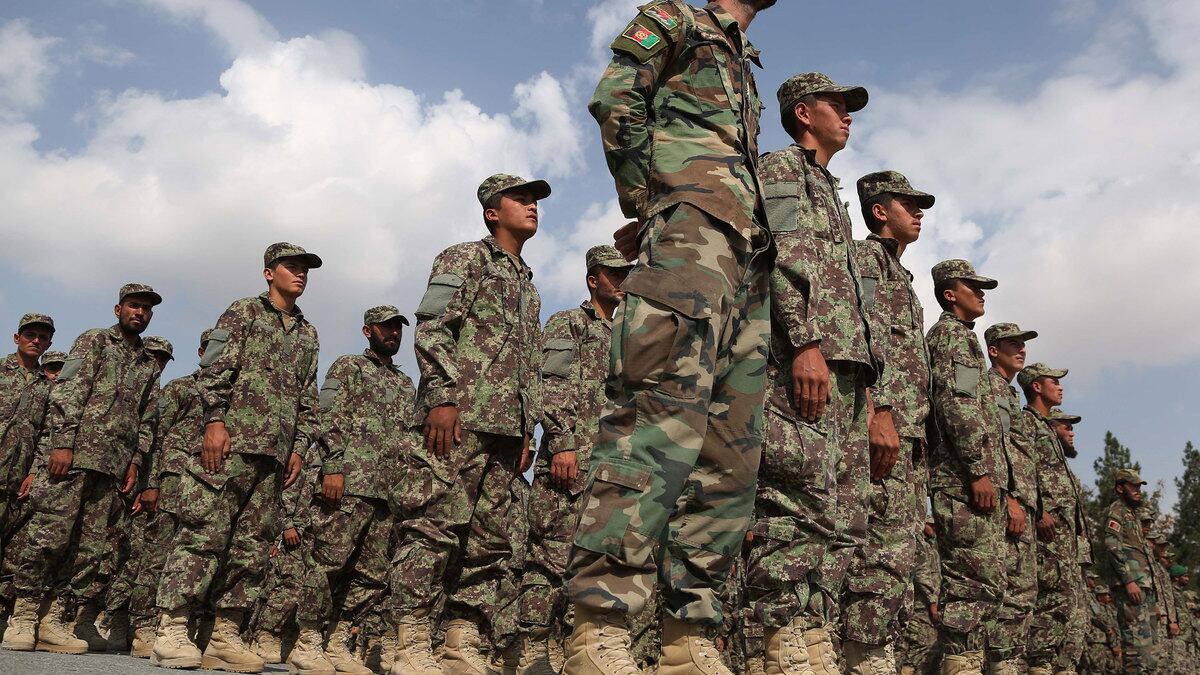“What we’re seeing is the rapid loss of district centers,” declared Austin Miller, the last four-star general to preside over U.S. and NATO forces in Afghanistan, at the tail end of June. It was a rare display of unfettered public candor by a senior American official responsible for prosecuting this country’s longest war. As I write this in the second week of August, the Taliban, the same politico-military organization the United States defeated handily over a couple of months in 2001-2002 with the aid of a coalition of Afghan warlords, appears on the verge of thoroughly routing government security forces, not only in the rural areas where it has been gaining steady ground since about 2015 but also in the cities.
On one day, Aug. 8, the insurgents seized three northern provincial capitals, including Kunduz, a major commercial hub with a population of more than 350,000 souls. They have since pressed forward into other key cities, including Kandahar and Lashkar Gah, the capital of the southern Helmand Province.
Pretty much every Western military and political analyst predicted that the Taliban would go on a major offensive as the United States began to withdraw its last military assets from the country, but few indeed thought the collapse of Kabul’s security forces would be as rapid and precipitous as it has been recently. According to a report by the authoritative Afghanistan Analysts Network, an astonishing 129 district centers fell into the hands of Taliban forces between May 1 and June 29, out of a total of about 420 districts in the entire country. Sixty of those districts fell in nine northern provinces, where the insurgents are seeking to block a reconstitution of the Northern Alliance the Americans cobbled together at the very beginning of this twenty-year war. Over those two months, the government forces lost at least 700 military vehicles to the enemy, along with huge stores of small arms and ammunition, and even a handful of artillery pieces. Without question, the losses have been even more substantial in July and August.
The United States spent more than $70 billion dollars to train and equip the Afghan National Security Forces—both police and army—but in the face of the recent Taliban offensive, dozens of units have simply vanished into thin air, deserting their posts and wandering off. Others have reached accommodation with local Taliban leaders, and turned over their positions without firing a single round. Still other government units have surrendered after they were surrounded and cut off by insurgents, or because they were betrayed by relief force commanders who decided it would be best to forego their mission entirely and call it a day.
So much for fighting spirit and military cohesion...
Why is the Afghan National Army collapsing? On a tactical and operational level, the answer is simple: the Afghan National Army has never severed its umbilical cord to U.S. logistics, air support, and intelligence gathering, even though the main mission of U.S. forces in the country since 2014 has been to prepare the national army and police to operate independently. Without these assets, government forces simply cannot stand up against a highly-motivated, well-supplied enemy like the Taliban.
Over the last three years, the vast majority of the government’s ground forces have been tied down manning a vast network of bases and outposts, many of which they inherited from the Americans. These units are generally regarded as of low quality and even lower morale, and they suffer from a very high desertion rate, even when not under pressure from Taliban units. They have been rarely used in offensive operations, because they typically break and run under fire.
Kabul has had to rely almost exclusively on the Afghan National Commando Corps to retake key towns, secure key lines of communication, and even to hold down key defensive positions. The Commando Corps soldiers undergo a rigorous 14-week training regimen akin in many ways to the training regimen used by U.S. Army Rangers and Marines. All volunteers drawn from the regular army, the Commandos have exhibited an admirable esprit and resilience, and were often successful in defeating Taliban forces, until quite recently.
But they have been bearing an overwhelming burden in the struggle to contain the expansion of territory under the control of the insurgency for about five years now. By 2017, a Department of Defense study found that the Commandos, a force of 20,000 in an army of about 300,000, were responsible for conducting 70 to 80 percent of the actual fighting in the country. According to the U.S. government’s Special Inspector General for Afghanistan Reconstruction, a watchdog agency, the number of missions assigned to the Commandos in the first quarter of 2021 was nearly double that of the last quarter of 2020.
Now, the Commandos are beginning to fail, as a result of exhaustion and the gradual disintegration of support units in the regular army they require to function. Early on the morning of June 16, a reinforced platoon of 50 Commandos ousted the Taliban from the district center of Dawlat Abad in the northern province of Faryab. The unit had been in heavy combat for 50 straight days. A few hours after the Commandos took the district, a large Taliban force returned and began an assault from multiple directions. Frantic calls for reinforcements from the Commandos went unanswered, despite the fact that a unit of 170 Afghan regular soldiers had been assigned to reinforce the initial strike force. Nor could the Afghan air force, maintained largely by American contractors who have now left the country, provide the Commandos with any air support.
The Taliban killed 24 Commandos and five policemen attached to the unit. As the grim struggle goes forward, it’s inevitable that other Commando will suffer a similar fate, for even the elite elements of the Afghan National Army cannot operate without substantial U.S. logistical and air support—a fact confirmed as recently as this past March in hearings before the Senate Armed Services Committee by U.S. Army General Richard Clarke, the top commander of all U.S. Special Operations Forces. The American Special Forces bear the primary responsibility for training the Afghan Commandos.
Yet there is a much more fundamental problem with the Afghan army than its inability to conduct successful military operations independently. Armies are invariably reflections of the government they are meant to serve. This certainly holds true for the Afghan government’s security forces.
Like the government in Kabul, the Afghan National Army is drenched in dysfunction, division, and most of all, debilitating corruption. The government has failed to address these problems for years. Nor did the senior leadership of Asraf Ghani’s administration develop a coherent politico-military strategy for tackling the Taliban on its own, though it has known for years that such a strategy would be required for long-term survival. Kabul’s internal paralysis and tensions ensure that even if it had a coherent plan, it could not implement it.
As Anthony Cordesman, an American strategic analyst known for his clinical detachment, wrote in a recent report for the International Institute for Strategic Studies in Washington, the government in Kabul “is dominated by leaders more interested in competing for power than in the nation’s future, and it cannot govern or make effective use of its funding, most of which comes from U.S. and outside aid. The political structure of the Afghan central government remains a corrupt and divided mess.”
Is it any wonder in these circumstances that the vast majority of the soldiers in the Afghan army fight for a pay check, not out of patriotism, or a sense of duty to the people of the country or the government they ostensibly serve? Is it any wonder that legions of ordinary Afghan citizens in the countryside have come to see the government forces as a greater adversary than the Taliban, when those forces extort money and goods from ordinary citizens, show callous disregard for civilian lives in executing their operations, and cannot find a way to provide basic security for people to carry on with their lives?
While the ministers in Kabul fumble and scheme, the Taliban have put on an insurgency clinic at the government’s expense. Amply funded, well organized, and deeply committed to their cause, the Taliban look increasingly unstoppable. Hard as it is for Westerners to swallow, the Taliban’s medieval vision of a society based on Islamic fundamentalism now seems a viable choice for millions of Afghans who are disillusioned with the corruption and dysfunction of a central government created and sustained by the United States of America. As Carter Malkasian, a historian and long-time political adviser to the American military in Afghanistan, put it in a recent article in Politico, the Taliban have been able “to tie themselves to religion and Afghan identity in a way that a government allied with a non-Muslim foreign countries could not match.”
The parlous state of the Afghan government and security forces reflects a fundamental reality of the place that seemed to escape the notice of the people in the Bush administration who came up with the crazy idea of building a democracy in Afghanistan in the first place. The country, writes the British scholar-journalist Anatol Lieven, “is divided along many lines, which often crisscross one another in highly confusing ways.” There are tensions and mistrust between the Pashtuns and the Tajiks, the two largest ethnic groups, as well as between those two groups and the smaller populations of Uzbeks and Hazaras, between regional warlords, and a profoundly deep divide between the liberal world of educated Afghans in Kabul and the people who dwell in the deeply conservative countryside. As Lieven puts it, while the nation has a central government and an army, “in practice it is incapable of extending real administration to most of its own territory, or of keeping its own followers loyal to the state rather than other centers of power.”
Twenty years after the American crusade in Afghanistan began, the U.S.-driven experiment with representative government in the country is collapsing before our eyes, and the Taliban are—once again—the dominant political and military force in “the graveyard of empires.”






